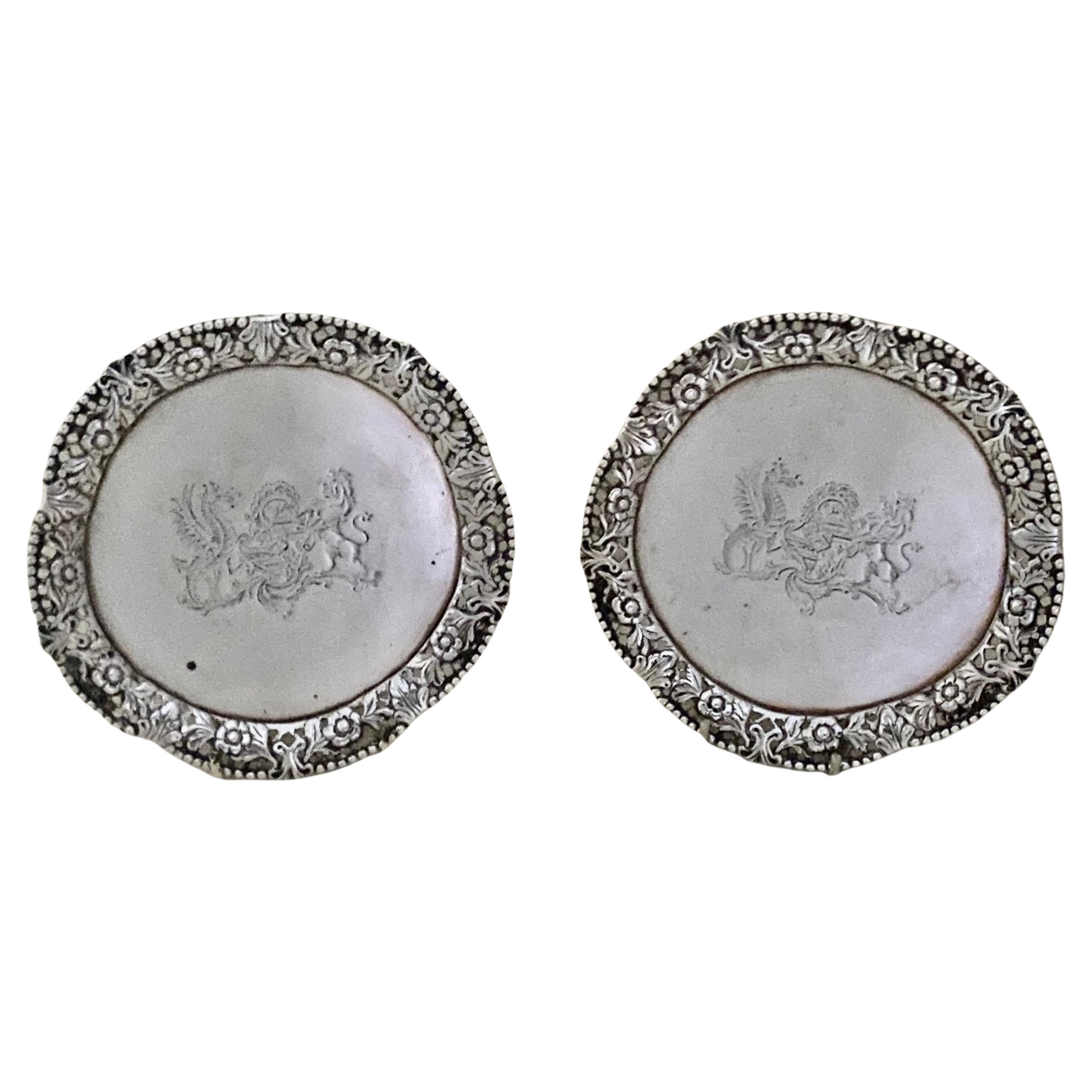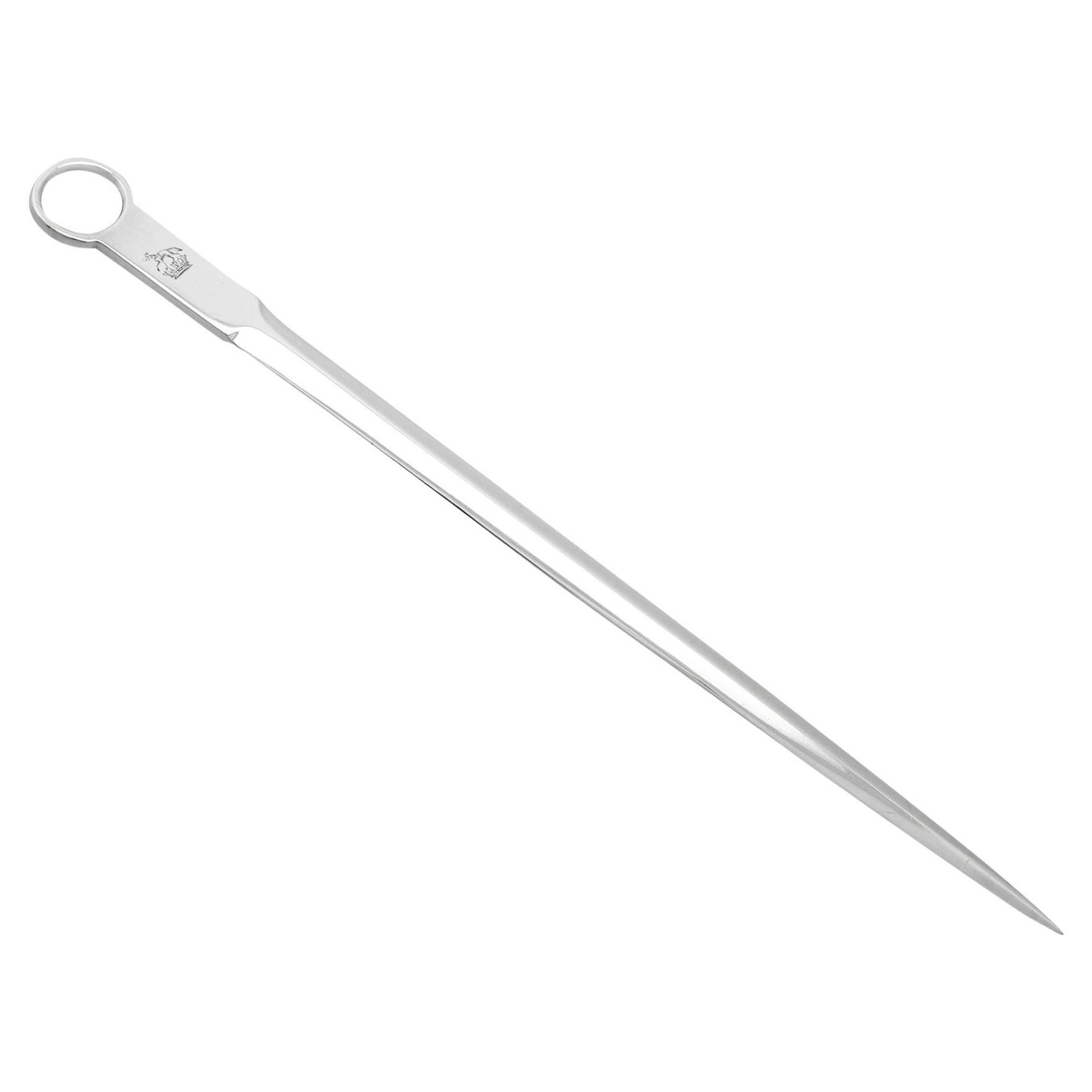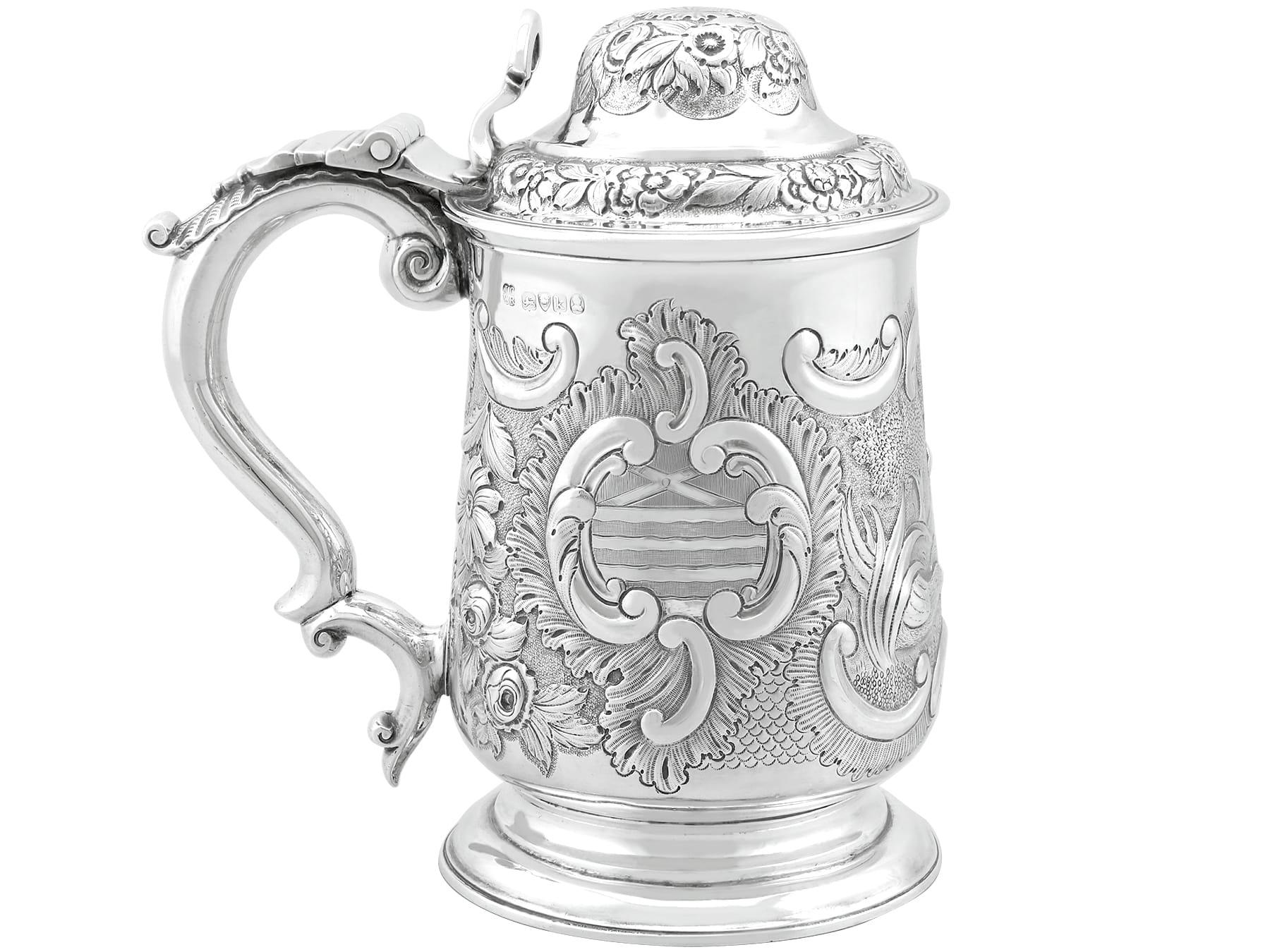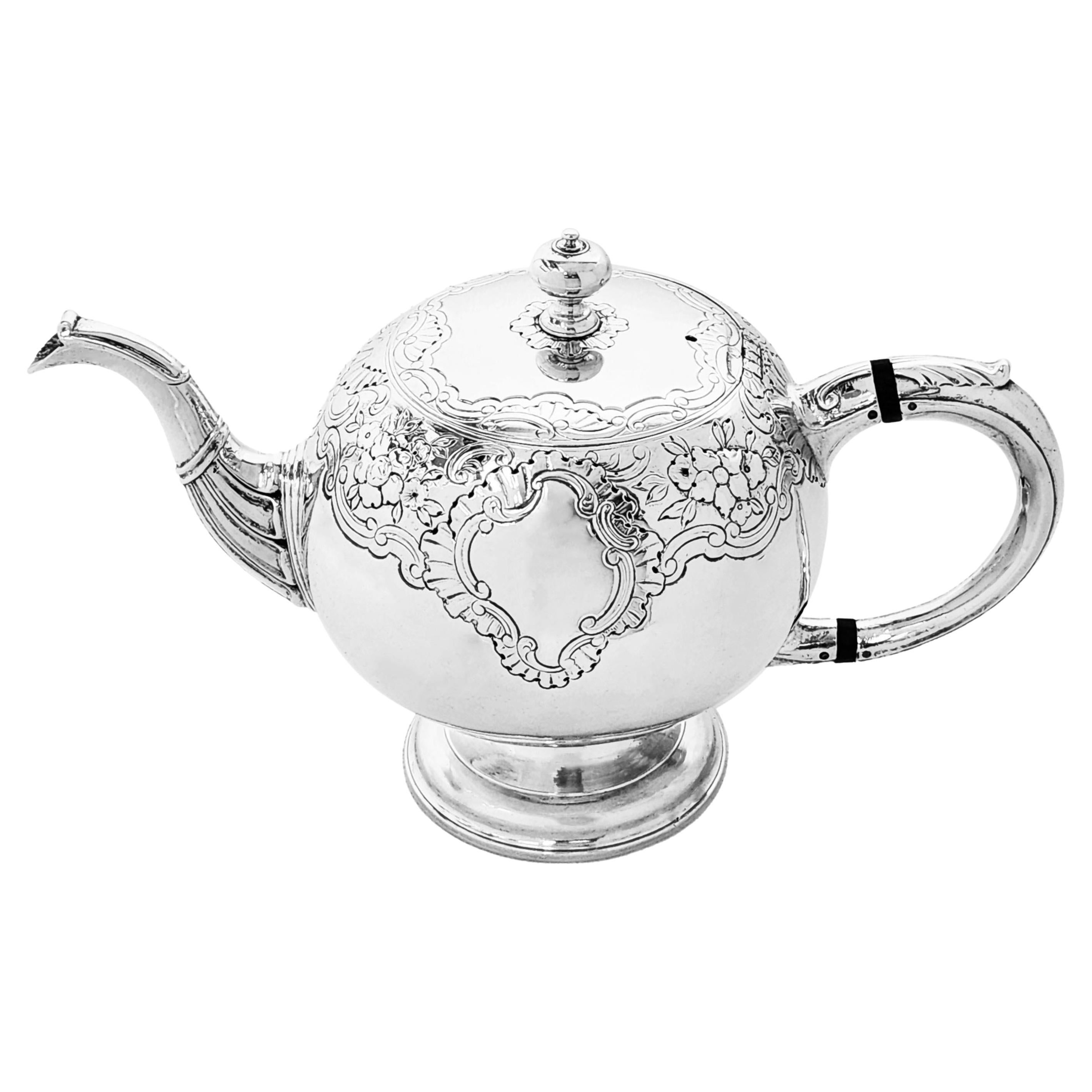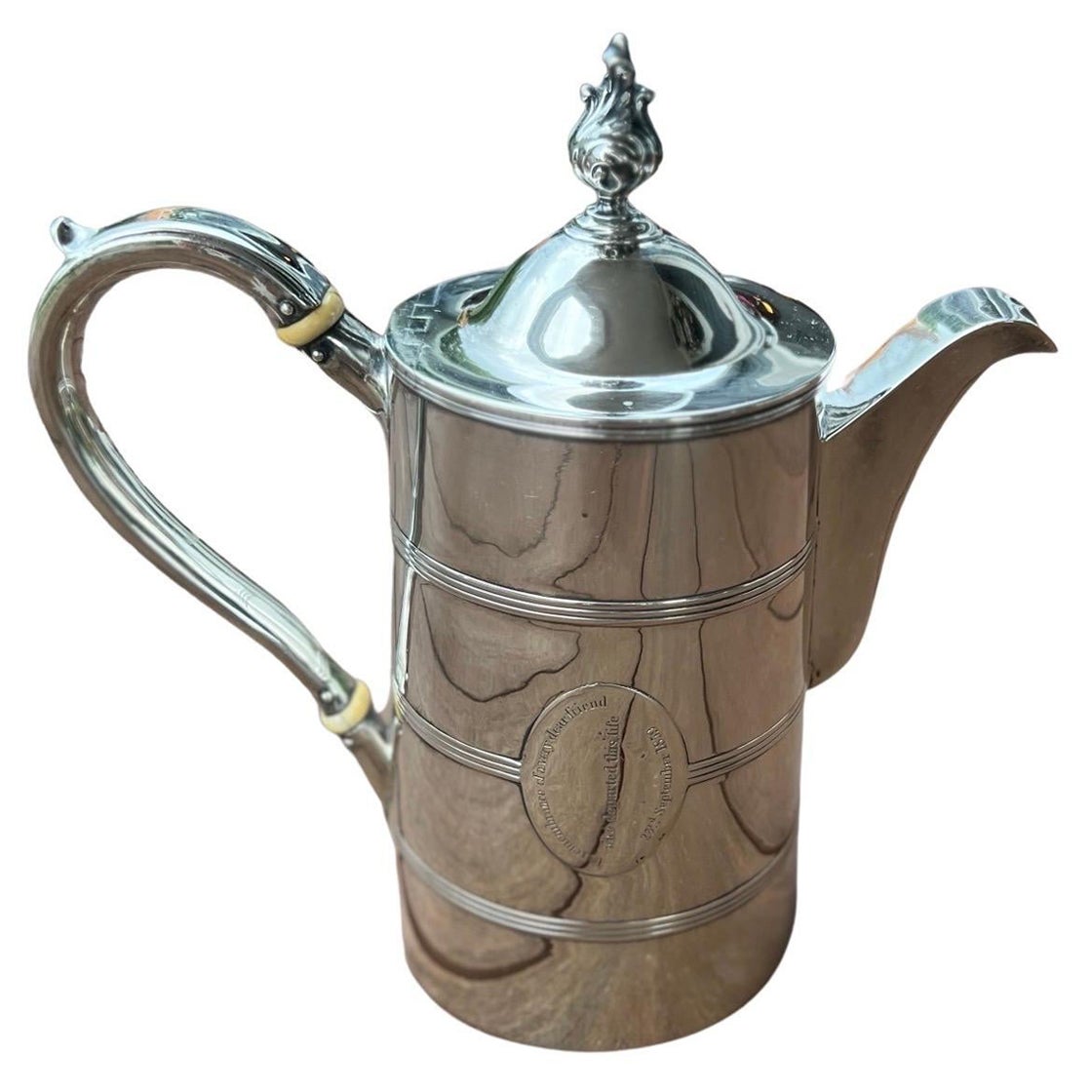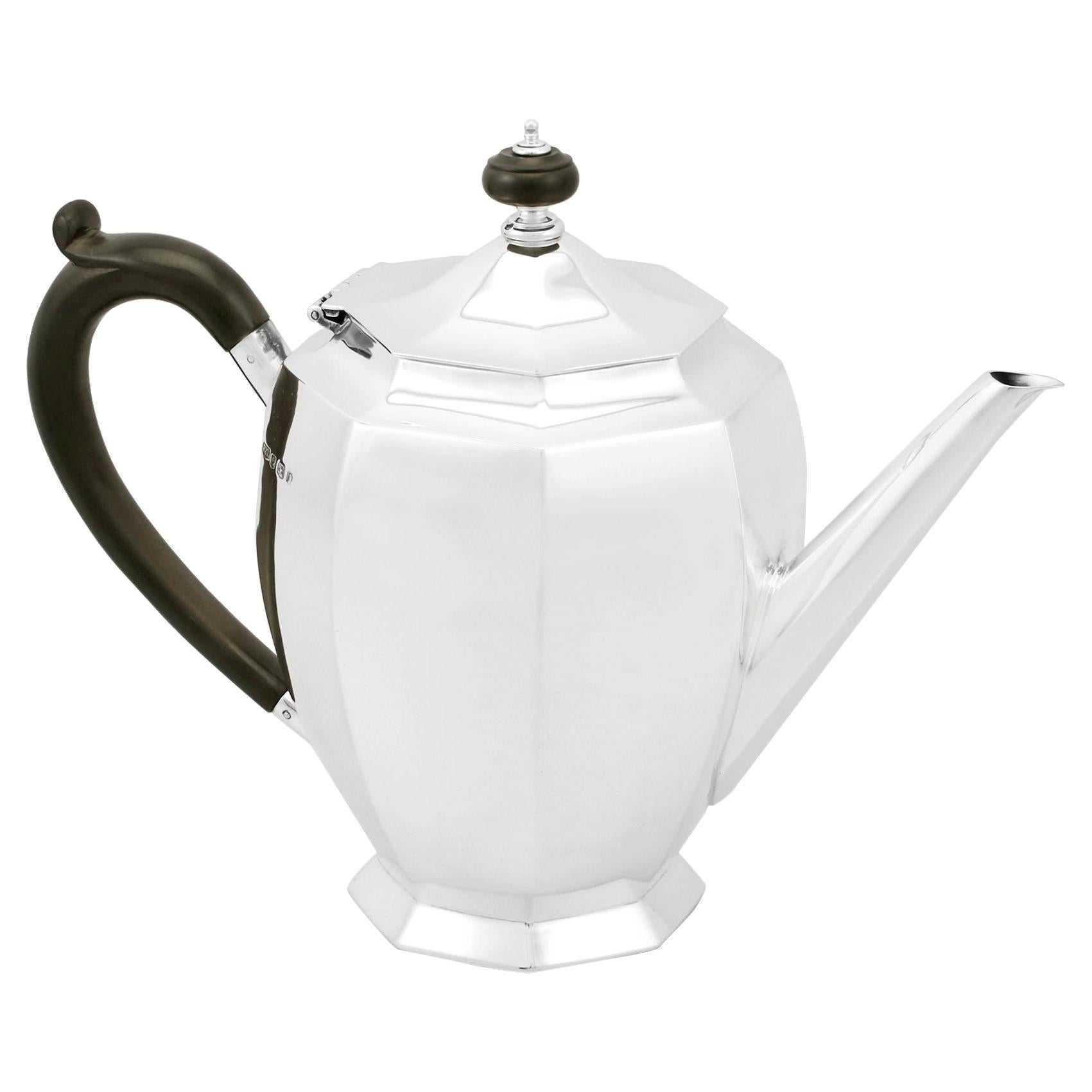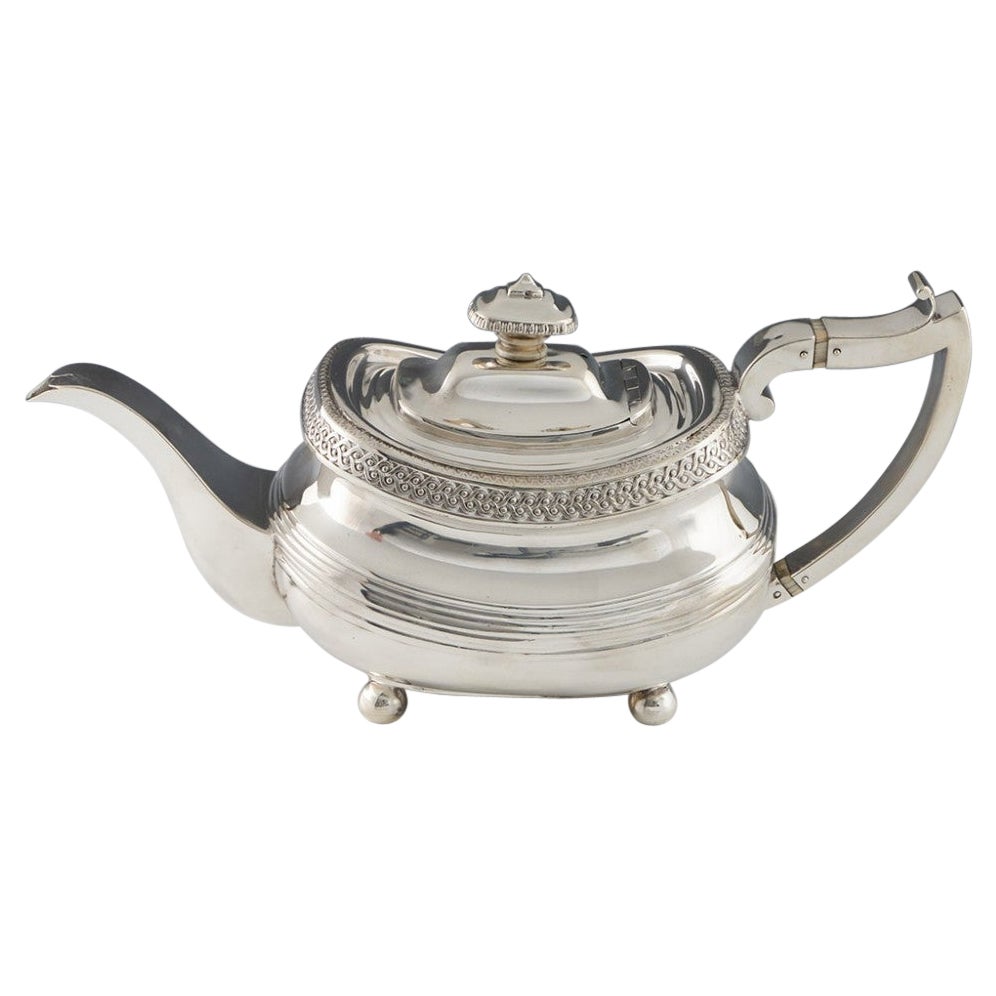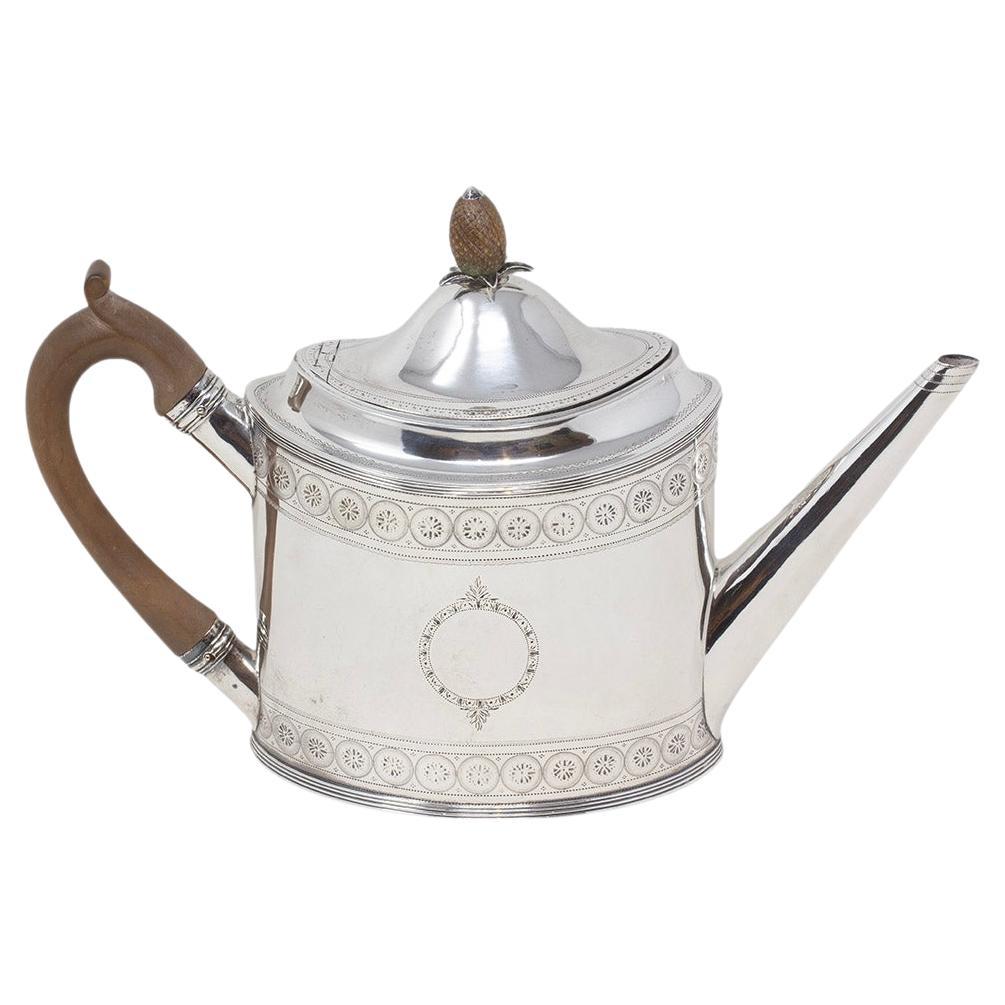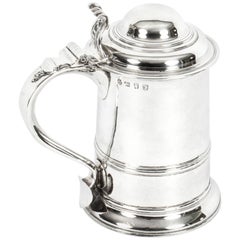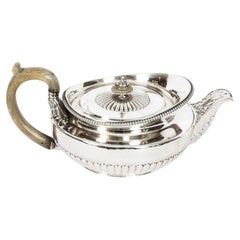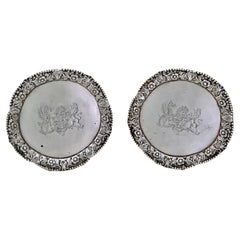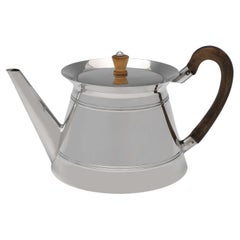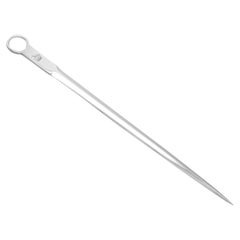
Antique George IV English Silver Teapot 1827
View Similar Items
Want more images or videos?
Request additional images or videos from the seller
1 of 11
Antique George IV English Silver Teapot 1827
About the Item
- Dimensions:Height: 5.12 in (13 cm)
- Materials and Techniques:
- Place of Origin:
- Period:
- Date of Manufacture:1827
- Condition:Excellent condition, please contact dealer for full condition report.
- Seller Location:London, GB
- Reference Number:Seller: 04359 1stDibs: LU9506787781
About the Seller
5.0
Platinum Seller
These expertly vetted sellers are 1stDibs' most experienced sellers and are rated highest by our customers.
Established in 1983
1stDibs seller since 2012
1,204 sales on 1stDibs
Typical response time: 1 hour
Associations
LAPADA - The Association of Arts & Antiques Dealers
More From This SellerView All
- Antique English George III Silver Tankard Thomas Whipham & Charles Wright, 1759By Thomas Whipman & Charles WrightLocated in London, GBThis is a fantastic large antique English George III sterling silver tankard/ beer stein with hallmarks for London 1759, and makers' mark of Thomas Whipham...Category
Antique 1750s English George III Sterling Silver
MaterialsSterling Silver
- Antique Rare Georgian Sterling Silver Teapot by Paul Storr 1817, 19th CenturyBy Paul StorrLocated in London, GBThis is an exceptional and very rare antique English George III sterling silver teapot by the world-famous silversmith, Paul Storr, and bearing hallmarks for 1817. This splendid teapot is of a delightful shape and it is profusely chased with half ribbed fluting decoration. It is further embellished with wonderful foliate motifs below and above the spout and stunning gadrooned shaped borders to the top of the teapot and the base. The remarkable quality flush hinged lid is also beautifully surmounted by a delightful round finial. It features an exceptional horn handle with striking details, proving the silversmith's exceptional mastery in the creation of unique and luxurious silverware - Paul Storr never tired of adding detail to create a true piece of artwork. The underside of the teapot bear full hallmarks: the Lion passant for sterling silver, the leopard head for London, the letter for 1817 and the maker's marks 'PS' for Paul Storr. There is no mistaking its unique quality and design, which is sure to make it a treasured piece by any discerning collector. Condition: In excellent condition with clear hallmarks and no dings, dents or signs of repair. Please see photos for confirmation. Dimensions in cm: height 12.5 x width 18 x depth 18 Weight 0.88 kg Dimensions in inches: height 5 inches x width 7 inches x depth 7 inches Weight 28.2 troy oz Paul Storr born in London England in 1771, was to become one of the most talented silversmiths of the nineteenth century. Today his legacy of exceptionally well crafted silver, found worldwide in museums and private collections, leaves one in awe when compared to that of his contemporaries.After having served a seven year apprenticeship from the age of 14, he began his career in 1792 when he went into a brief partnership with William Frisbee. This did not last and in 1793 a new mark, (his initials ‘P S’) was entered. By the beginning of the nineteenth century he had established himself as one of London’s top silversmiths producing, amongst others, commissions for Royalty. In 1801 he married Elizabeth Susanna Beyer with whom he was to have ten children. In 1807 Paul Storr entered into a working relationship with Philip Rundell and by 1811 was a partner, and managing the workshops for Rundell, Bridge & Rundell. During this period he kept his own marks and separate workshop. However it was through Rundell, Bridge & Rundell who were appointed Goldsmith in Ordinary to George III in 1804 that his reputation as a master silversmith grew. His talents lay in being able to transform ideas and designs from Rundell, Bridge & Rundell’s designers, William Theed...Category
Antique 1810s English George III Sterling Silver
MaterialsSterling Silver
- Antique English Sterling Silver Card Case Mappin & Webb 1904By Deakin & FrancisLocated in London, GBThis is a stylish antique Edwardian sterling silver card case with hallmarks for Birmingham 1904 and the makers mark of the renowned silversmiths Deakin & Francis Ltd, in the origina...Category
Antique Early 1900s English Edwardian Sterling Silver
MaterialsSterling Silver
- Antique Large William IV Silver Tray Salver by Paul Storr 1837 19th CenturyBy Paul StorrLocated in London, GBThis is a wonderful English antique William IV sterling silver tray, or salver, by the world famous silversmith Paul Storr. It has clear hallmarks for London 1837 the makers mark of Paul Storr and is also engraved Storr & Mortimer 36, they were Goldsmiths and Jewellers to Her Majesty’ (1822-1839). It is typical of his work with the octafoil shape and the exquisitely detailed foliate and acorn rim. It is raised on four delightful foliate and scroll feet. The centre is engraved with a shield shaped coat of arms encompassing the lion rampant which I have had researched: The Arms of the Family of King The arms as engraved upon this William IV English Sterling Silver Footed Salver by Paul Storr hallmarked London 1837 are those of the family of King. They may be blazoned as follows: Arms: Sable a lion rampant between three crosses formy fitchy argent Undoubtedly this salver was in the possession of a gentleman who was member of a family bearing the name of King. There are a number of variants of these armorial bearings being borne by King families. Very often the lion is of a different tincture but the field of the shield is invariably remains ‘sable’. Similar arms and crest were recorded by Sir Edward Bysshe, Clarenceux King of Arms in his Visitation of the County of Kent of 1663 to the family of King, of Bromley. The tinctures of both arms and crest of King, of Bromley were slightly different to those engraved upon this tureen in that the Visitation family’s arms were ‘Sable a lion rampant ermine between three crosses paty fitchy or’ 1 and the crest ‘A lion’s gamb erect and erased sable holding a cross paty fitchy or’(see illustration below). These arms and crest were granted by Sir Edward Walker, Garter King of Arms on the 20th February 1660 – 61; and yet another Kentish family of King, of Bellevue who were created Baronets within the Baronetage of Great Britain in 1792 bore for their arms ‘Sable a lion rampant erminois between three crosses paty fitchy or’. Their crest being the same as the family of King, of Bromley. There is no mistaking its unique quality and design, which is sure to make it a treasured piece by any discerning collector. Please see potos of the 2nd Baronet Timothy Shelley, 1753-1844 and Castle Goring, his home. Condition: In excellent condition with clear hallmarks and no dings, dents or signs of repair. Please see photos for confirmation. Dimensions in cm: height 4 x width 44 x depth 44 Weight 1.96 kg Dimensions in inches: height 2 inches x width 1 foot, 5 inches x depth 1 foot, 5 inches Weight 63 troy oz Paul Storr born in London England in 1771, was to become one of the most talented silversmiths of the nineteenth century. Today his legacy of exceptionally well crafted silver, found worldwide in museums and private collections, leaves one in awe when compared to that of his contemporaries.After having served a seven year apprenticeship from the age of 14, he began his career in 1792 when he went into a brief partnership with William Frisbee. This did not last and in 1793 a new mark, (his initials ‘P S’) was entered. By the beginning of the nineteenth century he had established himself as one of London’s top silversmiths producing, amongst others, commissions for Royalty. In 1801 he married Elizabeth Susanna Beyer with whom he was to have ten children. In 1807 Paul Storr entered into a working relationship with Philip Rundell and by 1811 was a partner, and managing the workshops for Rundell, Bridge & Rundell. During this period he kept his own marks and separate workshop. However it was through Rundell, Bridge & Rundell who were appointed Goldsmith in Ordinary to George III in 1804 that his reputation as a master silversmith grew. His talents lay in being able to transform ideas and designs from Rundell, Bridge & Rundell’s designers, William Theed...Category
Antique 1830s English William IV Sterling Silver
MaterialsSterling Silver
- Antique Large William IV Silver Tray Salver by Paul Storr 1820 19th CenturyBy Paul StorrLocated in London, GBThis is a wonderful English antique William IV sterling silver tray, or salver, by the world famous silversmith Paul Storr. It has clear hallmarks for London 1820 the makers mark of Paul Storr. It is typical of his work with the octafoil shape and the exquisitely detailed reeded rim, and it is raised on four delightful foliate and scroll feet. The centre is engraved with a shield shaped coat of arms which I have had researched. The Marital Arms of Knollis and Hallifax The armorial bearings as engraved upon this George IV Large English Sterling Silver Footed Salver by Paul Storr hallmarked London 1820 are those of the family of Knollis with Hallifax in pretence. These armorial bearings denote the marshalling of a marital coat showing the arms of the husband over the entire surface of the shield, whilst the arms of the wife (as an heraldic heiress) are placed on a small shield (known as an escutcheon of pretence) centrally on the husband’s arms. They may be blazoned as follows: Arms: Quarterly 1st and 4th Azure crusily of cross crosslets a cross moline voided or (for Knollys) 2nd and 3rd Gules on a chevron argent three roses of the field barbed proper (for Knollys) over all an escutcheon of pretence Or on a pile engrailed sable between two fountains barry wavy of six argent and azure three cross crosslets of the first (for Hallifax) Crest: An elephant argent [differenced with a mullet1 ] (for Knollys) Motto: In utrumque paratus [Prepared for either] (for Knollys) These armorial bearings undoubtedly commemorate the marriage of The Honourable and Reverend Francis Knollis2 (baptised 3rd January 1743 died 27th February 1826), 1 The cadency mark for a third son of a family. 2 Francis appears to have preferred this spelling of his family’s surname. It is spelt as it is to be pronounced. of Burford in the County of Oxfordshire and of Eastleach Martin in the County of Gloucestershire and Mary Hallifax (baptised 5th March 1753 buried 18th December 1830). Francis and Mary were married at the Parish Church of St Mary, Ewell in the County of Surrey on the 9th June 1772. Francis was the third son of Charles Knollys (the titular 5th Earl of Banbury) 3 and his wife, Martha Hughes, whilst Mary was the daughter of The Reverend James Hallifax, of Ewell aforesaid and his wife, Elizabeth Chardavoyn. 3 Francis’s father claimed to be the 5th Earl of Banbury. A claim that continued to be pursued by the family until William Knollys, the titular 8th Earl of Banbury (born 1763 died 1834) was forced to discontinue its use by a resolution of the House of Lords which rejected his claim to the earldom in 1813. The crest surmounts a detailed dedication: This piece of plate was presented to the Honourable Rev Knolls by the inhabitants of the town and immediate neighbourhood of Burford on his completing the fiftieth year of his incumbency as the vicar of Burford. In testimony of their high respect 11th April 1821 There is no mistaking its unique quality and design, which is sure to make it a treasured piece by any discerning collector. Condition: In excellent condition with clear hallmarks and no dings, dents or signs of repair. Please see photos for confirmation. Dimensions in cm: Height 3 x Width 36 x Depth 36 Weight 1.52 kg Dimensions in inches: Height 1 inch x Width 1 foot, 2 inches x Depth 1 foot, 2 inches Weight 49 troy oz Paul Storr born in London England in 1771, was to become one of the most talented silversmiths of the nineteenth century. Today his legacy of exceptionally well crafted silver, found worldwide in museums and private collections, leaves one in awe when compared to that of his contemporaries.After having served a seven year apprenticeship from the age of 14, he began his career in 1792 when he went into a brief partnership with William Frisbee. This did not last and in 1793 a new mark, (his initials ‘P S’) was entered. By the beginning of the nineteenth century he had established himself as one of London’s top silversmiths producing, amongst others, commissions for Royalty. In 1801 he married Elizabeth Susanna Beyer with whom he was to have ten children. In 1807 Paul Storr entered into a working relationship with Philip Rundell and by 1811 was a partner, and managing the workshops for Rundell, Bridge & Rundell. During this period he kept his own marks and separate workshop. However it was through Rundell, Bridge & Rundell who were appointed Goldsmith in Ordinary to George III in 1804 that his reputation as a master silversmith grew. His talents lay in being able to transform ideas and designs from Rundell, Bridge & Rundell’s designers, William Theed...Category
Antique 1820s English William IV Sterling Silver
MaterialsSterling Silver
- Antique Sterling Silver Call Desk Table Bell, George Unite 1886 19th CenturyBy George UniteLocated in London, GBA delightful antique English Victorian sterling silver call bell, bearing the makers mark of the renowned silversmith George Unite and hallmarks for Birmingham 1888 and Patent 801. ...Category
Antique 1880s English Victorian Sterling Silver
MaterialsSterling Silver
You May Also Like
- Pair of George IV Sterling Silver Salvers London, 1827Located in London, GBA very fine pair of George IV shaped circular salver, waiters with a cast gallery, Standing on three openwork, foliate feet, the centre engraved bearing the coat-of-arms of Lady Mari...Category
Antique 1780s British George III Sterling Silver
MaterialsSterling Silver
- George V Antique English Sterling Silver Teapot, Birmingham 1913 Haseler BrosBy Edward John & Noble HaselerLocated in London, LondonHallmarked in Birmingham in 1913 by Edward & Noble Haseler, this very stylish, Antique Sterling Silver Teapot, features tapering sides, reed detailing, a wooden handle and a pull off...Category
Vintage 1910s English Sterling Silver
MaterialsSterling Silver
- George IV English Sterling Silver Meat Skewer/ Letter OpenerLocated in Jesmond, Newcastle Upon TyneAn exceptional, fine and impressive, large antique George IV English sterling silver meat skewer or letter opener; an addition to our diverse flatware collection. This exceptional and large antique George IV sterling silver meat skewer/letter opener has a tapered form. The surface of this skewer is embellished with a contemporary bright cut engraved crest of upon a naval crown thereon a fox passant, all below the plain circular ring loop finger piece. The reverse surface is plain and unembellished apart from the featured hallmarks. The initials within the maker's marks, in addition to the standardisation of the surround could pertain to a multitude of antique silversmiths; these silvermsiths include William Eaton, Esterbrook and Eley II. This impressive skewer is larger example of its type than you would expect to find. The original use of this item was purely as a silver meat skewer. Due to its form, this piece may certainly be used as an effective letter opener. Given the evidence of the crest (with its label of three points charged upon the fox’s breast) engraved upon this meat skewer it was undoubtedly in the possession of Rear Admiral Edward Le Cras Thornbrough (born 1st March 1795 died 25th December 1857) the only surviving child of Admiral Sir Edward Thornbrough, GCB and his first wife, Ann Le Cras. Rear Admiral Thornbrough was son and grandson of Royal Naval officers. His father Admiral Sir Edward Thornbrough was a senior, long-serving veteran officer of the Royal Navy during the late eighteenth and early 19th century having seen action in the American Revolutionary War, the French Revolutionary Wars and the Napoleonic Wars; whilst his grandfather was Commander Edward Thornbrough. Rear Admiral Thornbrough entered the Royal Navy in 1806 and saw action throughout the later Napoleonic period on both the Home and Mediterranean stations. He married Emily Raikes Garrett, the second daughter of Daniel Garrett, of Colt House, near Honiton in the County of Devon on the 30th November 1820. Condition This antique antique meat skewer...Category
Antique 1820s English George IV Sterling Silver
MaterialsSilver, Sterling Silver
- 1830s English Sterling Silver TeapotLocated in Jesmond, Newcastle Upon TyneAn exceptional, fine and impressive antique William IV English sterling silver teapot; an addition to our silver teaware collection. This impre...Category
Antique 1830s English Sterling Silver
MaterialsSterling Silver
- Antique George IV Sterling Silver Vinaigrette William ElliottLocated in Uckfield, SussexA fine George IV silver-gilt vinaigrette, slender rounded rectangular form, engine-turned decoration, the silver-gilt interior with a finely pierced and engraved foliate grille. M...Category
Antique 1820s English George IV Sterling Silver
MaterialsSilver
- Antique George IV 1820s Sterling Silver Quart TankardBy Joseph Craddock 1, William Ker ReidLocated in Jesmond, Newcastle Upon TyneA fine and impressive antique George IV English sterling silver quart tankard; an addition to our silver tankard collection. This exceptional antique George IV sterling silver qua...Category
Antique 1820s English George IV Barware
MaterialsSilver, Sterling Silver
Recently Viewed
View AllMore Ways To Browse
Sterling English Teapot
English Sterling Silver Teapot
Antique Outlets
Antique Outlet
Teapot 19th C
Old Antique Teapots
1840 Silver Teapot
George I Teapot
John Angell
Senior Jo
Panton Junior
Henry Chase
Sheffield England Flatware
Chinese Export Silver Bamboo
Vintage Gorham Sterling Flatware Patterns
Antique Sterling Silver Ring Box
Antique Sterling Silver Ring Box Boxes
William Hutton And Son
